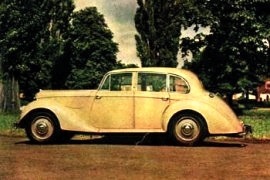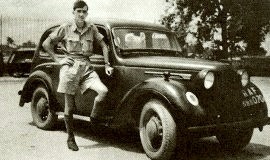|
|
It is stating the obvious that World War 2 interrupted the steady progress of the motor car. When the war ended, production continued from where it had ceased in 1939, and the pressed-steel bulbousness of the late 1930s was projected well into the 1940s. Bentley, however, continued to produce excellently styled cars right up to the war; and afterwards. W. O. Bentley created the 2.5-litre Lagonda in 1947 before David Brown took over the Lagonda company. The pressed- steel 2.5-litre model had little of the character of his earlier masterpieces but, even so, avoided some of the excessive curves found in so many other cars, such as the Standard Vanguard and the Ford Pilot. |
 |
 |
 |
Armstrong Siddeley Lancaster |
| |
|
| |
Armstrong Siddeley started post-war production in November 1945 with the 16 HP Lancaster Saloon and Hurricane Drophead Coupe, supplemented by the Typhoon Two-door Saloon from August 1946. They remained in production until September 1949, when the engine was uprated. 1945-49 models had a 1991-cc (65 x 100 mm) 70-bhp OHV power unit. Wheelbase was 9 ft 7 in, tyre size 5.50-17. Pre-production Lancaster (pictured left) and Hurricane cars had made their debut as early as May 1945-during the same week as VE Day (Victory in Europe). |
|
 |
 |
 |
Austin Eight, Ten and Twelve |
| |
Also see: Austin Car Reviews |
| |
The Austin Tens, as well as Eight and Twelve, were reintroduced in 1945 with various improvements. Many of the changes were a result of wartime modifications to the Ten Light Utility which had been in almost continuous production during 1941-44. Basically, however, all three cars were much the same as in 1939/40. This advertisement appeared in the motoring press as early as February 1945. |
|
 |
 |
 |
Austin Sixteen Model BS1 |
| |
Also see: Austin Car Reviews |
| |
Austin Sixteen, Model BS1, was new in the Company's immediate post-war programme. This car was basically the same as the Twelve (HS1), but instead of a 1535-cc side-valve engine it had a new 2199-cc overhead-valve unit with an output of 58 bhp at 3700 rpm. The RAC rating was 15·99 HP. Automatic reversing light, built-in hydraulic jacks and heater were standard equipment on the Sixteen. The saloon illustrated was delivered to the RAF. Post-war production of the 8, 10,12 and 16 HP Saloons started in August 1945 and ceased in October 1947, with the exception of the 16 HP, which was continued until early 1949. In June 1946, the millionth car came off Austin's Longbridge assembly line. It was a Sixteen, finished in matt cream. |
|
 |
 |
 |
Ford Prefect 10 HP Model E93A |
| |
Also see: Ford UK Road Tests and Reviews |
| |
The Ford Prefect 10 HP Model E93A was put into production in October 1945. It was fundamentally the same as produced in 1939/40 and differed from the Anglia chiefly in the following respects: four-door bodywork with different front and rear end. 7 ft 10in wheelbase, 12 ft 11¼ in (v. 12 ft 8¼ in) overall length. 5.00-16 tyres and 63·5-mm cylinder bore, giving 1172-cc cubic capacity. Maximum power output with 6·16:1 CR. was 30 bhp. |
|
 |
 |
 |
Hillman 10 HP Light Utility |
| |
Also see: Hillman Road Tests and Reviews |
| |
Hillman 10 HP Light Utility, used in the Coventry Thanksgiving Week Procession on 13 October 1945. This is the final production type, featuring removable cab top and lifting sling flanges on the wheels.
|
|
 |
 |
 |
Hillman Minx |
| |
Also see: Hillman Road Tests and Reviews |
| |
The Hillman Minx was reintroduced in 1945, and Hillman claimed, no fewer than 57 improvements compared with the 1940 model, to which it looked identical. The price, in October 1946, was £442 and a Drophead Coupe was available at £525, both prices inclusive of PT.
|
|
 |
 |
 |
Humber 14HP Hawk, 18HP Snipe and 27HP Super Snipe |
| |
Also see: Hillman Road Tests and Reviews |
| |
The Humber post-war range comprised three five-seater saloons: the new 14 HP Hawk, the 18 HP Snipe and the 27 HP Super Snipe. In addition there was the seven-passenger 27 HP Pullman Limousine. Shown is a Super Snipe, belonging to Sir Graham and Lady Cunningham. This model, fundamentally the same as in 1940, was known as the Super Snipe Mark I. It had a 100-bhp 4-litre side-valve six-cylinder engine and was in production from August 1945 to September 1948.
|
|
 |
 |
 |
Standard FGPV (Farmers' General Purpose Vehicle) |
| |
Also see: Standard Road Tests and Reviews |
| |
Standard FGPV (Farmers' General Purpose Vehicle) was developed from the Model JAB 4 x 4 in 1944/45 and intended for civilian use after the war. As can be seen it was not unlike the SS VB, and both were clearly mini-versions of the US 'Jeep' The FGPV was expected to sell at between £100 and £140, but the project did not materialize. |
|
 |
|
 |
ZIS 110V |
| |
Also see: ZIS / ZIL Road Tests and Reviews |
| |
Production of the second generation ZIS started in August 1945, only 11 months after the prototypes got the Governments' blessing and a couple of months earlier than Packard launced its slippery Twenty-First series. The ZIS-110 was naturally very similar to its American counterpart and was to remain as the top motor car in the USSR until 1958. Many of the design group responsible for the car received a State Prize for their efforts. The 6-litre engine produced a claimed 140 bhp at 3,600 rpm and the new ZIS would do 87 mph. A special brand of high octane petrol was developed for this car. Although not easy to manoeuve, it was the fastest car in Russia in the 1950s. Generously sprung, many were made into ambulances, fitted with Red Cross lamps and a searchlight. No major body modifications were needed for the car to accept a stretcher, which was loaded through the standard boot lid. |
|
 |
|
 |
ZIS 110 |
| |
Also see: ZIS / ZIL Road Tests and Reviews |
| |
The ZIS 110 limousine also served as a taxi. Although it was employed mostly in cities it really belonged to the open road and before mini-buses were available the big ZIS's were in regular service between Moscow and the Black Sea holiday resorts. Its reputation remained untarnished in the minds of retired taxi drivers as a dependable, reliable, easy-to-live-with motor car. The ZIS-110 kept rofling off its slow production line for about 12 years. The cars weren't always black of course, biege and grey dominated on ambulances and the open top models. Even the formal limousines were sometimes painted in blue or turquoise hues. From 1956 the ZIS-110 became known as the ZIL-110 when Stalin (the "S" in "ZIS") had fallen out of favour... |
|
|
|
Sell Your Car or Parts
Browse the Classifieds
It's Absolutely Free! - Find Out More
|



